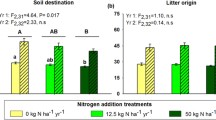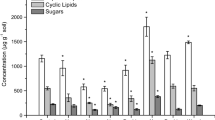Abstract
Although field studies have demonstrated an ecosystem-specific effect of experimental atmospheric nitrogen (N) deposition on litter decomposition, a mechanistic understanding of how ligninolytic microbial communities respond to atmospheric deposition is lacking. Because high levels of inorganic N suppress lignin decomposition by some basidiomycetes, it is plausible that the abundance and activity of these key microorganisms underlies differential ecosystem responses of decomposition to atmospheric N deposition. We hypothesize that: (a) atmospheric N deposition will cause an ecosystem-specific reduction in basidiomycete activity and abundance with greatest decreases in ecosystems with lignin-rich forest litter and (b) the abundance of lignin degrading basidiomycetes will be positively correlated with ligninolytic enzyme activity. To test these hypotheses, we measured the effects of experimental N deposition on the potential activity of phenol oxidase enzymes, and the abundance of basidiomycete genes encoding laccase, a primary phenol oxidase enzyme, in three hardwood forests spanning a range of leaf litter lignin content. The black oak-white oak (BOWO) contains high lignin litter, the sugar maple-basswood (SMBW) has low lignin litter, and the sugar maple-red oak (SMRO) is intermediate. An ecosystem by N deposition interaction significantly influenced phenol oxidase activity in the surface soil (P = 0.05), where phenol oxidase activity decreased with increasing experimental N deposition in the BOWO ecosystem. No consistent response to N deposition was evident for surface soil phenol oxidase activity within either the SMRO or SMBW ecosystem. This interaction did not influence laccase gene abundance. Instead, basidiomycete laccase gene abundance was reduced by experimental N deposition (main effect) in surface soil. There was only a weak correlation between basidiomycete laccase gene abundance and potential phenol oxidase enzyme activity, suggesting that the abundance of organisms possessing laccase genes may not control phenol oxidase activity in soil. Our results suggest that the regulation of laccase gene expression may mediate the decomposition response to atmospheric N deposition.



Similar content being viewed by others
REFERENCES
Baldrian P. 2006. Fungal laccases - occurrence and properties. FEMS Microbiol Rev 30:215–42
Bebber DP, Tlalka M, Hynes J, Darrah PR, Ashford A, Watkinson SC, Boddy L, Fricker MD. 2006. Imaging complex nutrient dynamics in mycelial networks. In: Gadd GM, Watkinson SC, Dyer PS, Eds. Fungi in the environment. New York: Cambridge University Press
Blackwood CB, Waldrop MP, Zak DR, Sinsabaugh RL. 2007. Molecular analysis of fungal communities and laccase genes in decomposing litter reveal differences among forest types but no impact of nitrogen deposition. Environ Microbiol 9:1306–16
Burns RG. 1982. Enzyme-activity in soil—location and a possible role in microbial ecology. Soil Biol Biochem 14:423–7
Burton AJ, Ramm CW, Pregitzer KS, Reed DD. 1991. Use of Multivariate Methods in Forest Research Site Selection. Can J For Res (Revue Canadienne De Recherche Forestiere) 21:1573–80
Carreiro MM, Sinsabaugh RL, Repert DA, Parkhurst DF. 2000. Microbial enzyme shifts explain litter decay responses to simulated nitrogen deposition. Ecology 81:2359–65
Chen DM, Bastias BA, Taylor AFS, Cairney JWG. 2003. Identification of laccase-like genes in ectomycorrhizal basidiomycetes and transcriptional regulation by nitrogen in Piloderma byssinum. New Phytol 157:547–54
Colao MC, Garzillo AM, Buonocore V, Schiesser A, Ruzzi M. 2003. Primary structure and transcription analysis of a laccase-encoding gene from the basidiomycete Trametes trogii. Appl Microbiol Biotechnol 63:153–8
DeForest JL, Zak DR, Pregitzer KS, Burton AJ. 2005. Atmospheric nitrate deposition and enhanced dissolved organic carbon leaching: test of a potential mechanism. Soil Sci Soc Am J 69:1233–7
Fog K. 1988. The effect of added nitrogen on the rate of decomposition of organic-matter. Biol Rev Camb Philos Soc 63:433–62
Frankland JC. 1998. Fungal succession—unravelling the unpredictable. Mycol Res 102:1–15
Gallo M, Amonette R, Lauber C, Sinsabaugh RL, Zak DR. 2004. Microbial community structure and oxidative enzyme activity in nitrogen-amended north temperate forest soils. Microbial Ecol 48:218–29
Galloway JN, Schlesinger WH, Levy H, Michaels A, Schnoor JL. 1995. Nitrogen-fixation—anthropogenic enhancement-environmental response. Global Biogeochem Cycles 9:235–52
Hammel KE. 1997. Fungal degradation of lignin. In: CGaG KE, Ed. Driven by nature: plant litter quality and decomposition. Wallingford: CAB International. pp 33–46
Hatakka A. 2001. Biodegradation of Lignin. In: Hofrichter M, Steinbüchel A, Eds. Lignin, humic substances and coal. New York: Wiley-VCH. pp 129–80
Knorr M, Frey SD, Curtis PS. 2005. Nitrogen additions and litter decomposition: a meta-analysis. Ecology 86:3252–57
Lilleskov EA, Fahey TJ, Horton TR, Lovett GM. 2002. Belowground ectomycorrhizal fungal community change over a nitrogen deposition gradient in Alaska. Ecology 83:104–15
Luis P, Walther G, Kellner H, Martin F, Buscot F. 2004. Diversity of laccase genes from basidiomycetes in a forest soil. Soil Biol Biochem 36:1025–36
Luis P, Kellner H, Martin F, Buscot F. 2005. A molecular method to evaluate basidiomycete laccase gene expression in forest soils. Geoderma 128:18–27
MacDonald NW, Witter JA, Burton AJ, Pregitzer KS, Richter DD. 1993. Relationships among atmospheric deposition, throughfall, and soil properties in oak forest ecosystems. Can J For Res (Revue Canadienne De Recherche Forestiere) 23:2348–57
Nagai M, Kawata M, Watanabe H, Ogawa M, Saito K, Takesawa T, Kanda K, Sato T. 2003. Important role of fungal intracellular laccase for melanin synthesis: purification and characterization of an intracellular laccase from Lentinula edodes fruit bodies. Microbiol Sgm 149:2455–62
Paul EA, Clark FE. 1996. Soil microbiology and biochemistry. San Diego: Academic
Pointing SB, Pelling AL, Smith GJD, Hyde KD, Reddy CA. 2005. Screening of basidiomycetes and xylariaceous fungi for lignin peroxidase and laccase gene-specific sequences. Mycol Res 109:115–24
Rabinovich ML, Bolobova AV, Vasil’chenko LG. 2004. Fungal decomposition of natural aromatic structures and xenobiotics: a review. Appl Biochem Microbiol 40:1–17
Ryan MG, Melillo JM, Ricca A. 1990. A comparison of methods for determining proximate carbon fractions of forest litter. Can J For Res (Revue Canadienne De Recherche Forestiere) 20:166–71
Saiya-Cork KR, Sinsabaugh RL, Zak DR. 2002. The effects of long term nitrogen deposition on extracellular enzyme activity in an Acer saccharum forest soil. Soil Biol Biochem 34:1309–15
Sinsabaugh RL, Zak DR, Gallo M, Lauber C, Amonette R. 2004. Nitrogen deposition and dissolved organic carbon production in northern temperate forests. Soil Biol Biochem 36:1509–15
Waldrop MP, Zak DR, Sinsabaugh RL. 2004a. Microbial community response to nitrogen deposition in northern forest ecosystems. Soil Biol Biochem 36:1443–51
Waldrop MP, Zak DR, Sinsabaugh RL, Gallo M, Lauber C. 2004b. Nitrogen deposition modifies soil carbon storage through changes in microbial enzymatic activity. Ecol Appl 14:1172–7
Worrall JJ, Anagnost SE, Zabel RA. 1997. Comparison of wood decay among diverse lignicolous fungi. Mycologia 89:199–219
Xiao YZ, Chen Q, Hang J, Shi YY, Wu J, Hong YZ, Wang YP. 2004. Selective induction, purification and characterization of a laccase isozyme from the basidiomycete Trametes sp AH28-2. Mycologia 96:26–35
Yang HH, Effland MJ, Kirk TK. 1980. Factors influencing fungal degradation of lignin in a representative lignocellulosic, thermomechanical pulp. Biotechnol Bioeng 22:65–77
Zak DR, Pregitzer KS. 1990. Spatial and temporal variability of nitrogen cycling in northern lower Michigan. For Sci 36:367–80
ACKNOWLEDGEMENTS
Our work was supported by a grant from the Carbon Sequestration Program of the Office of Science (BER), U.S. Department of Energy. We would like to thank Rebecca Mau for field assistance and Liz Kruszewski, Jennifer Jenkins and Zach Wallace for laboratory assistance.
Author information
Authors and Affiliations
Corresponding author
Rights and permissions
About this article
Cite this article
Hofmockel, K.S., Zak, D.R. & Blackwood, C.B. Does Atmospheric NO −3 Deposition Alter the Abundance and Activity of Ligninolytic Fungi in Forest Soils?. Ecosystems 10, 1278–1286 (2007). https://doi.org/10.1007/s10021-007-9096-x
Received:
Revised:
Accepted:
Published:
Issue Date:
DOI: https://doi.org/10.1007/s10021-007-9096-x




